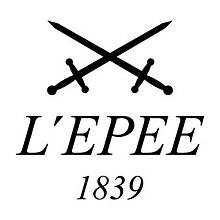L'Epée Clocks
This article has multiple issues. Please help improve it or discuss these issues on the talk page. (Learn how and when to remove these messages)
|
 | |
| Industry | Clockmaker |
|---|---|
| Founded | 1839 |
| Founder | Auguste l'Epée |
| Headquarters | Rue de Saint Maurice 1, 2800 Delémont,Jura, Switzerland, , |
| Parent | Swiza S.A. |
| Website | http://www.lepee1839.ch/ |
L'Epée is a Swiss luxury brand, specializing in manufacturing mechanical clocks. Its factory is in Delémont, in the Canton du Jura.[1]
History
[edit]
In 1839, Auguste L’Epée (1798–1875) and Pierre-Henri Paur (from Geneva) founded the L’Epée Manufacture in Saint-Suzanne in the Doubs department of France. At the time, the manufacturer produced horological products and music boxes.[2][3]
L’Epée submitted its first patents to the authorities in 1857. The company was recognized in the clock-making world for its platform escapements.
The company's reputation defined it as both the leader and a reference in escapements. The company's annual production of platform escapements gradually increased over two decades, culminating at 200,000 platform escapements in 1889.
The company won gold medals at World Fairs held in Paris, (1889 and 1900), Vienna (1892), Hanoi (1902), as well as World Fairs held in the U.S.A. and the UK.
During these first few decades, L’Epée diversified by producing other mechanical movements for both clockmaking (precision instruments, for example) and associated industries. 1975 marked a major turning point for the firm. New company directors reoriented production to focus on the design and creation of luxury clocks and carriage clocks. In 1976, the company participated in the Concorde project by fitting wall clocks in the eponymous supersonic airplane.
L'Epée unveiled the largest clock in the world at that time, known as "the Giant Regulator", earning it a place in the Guinness Book of Records. This one-off creation measures 2.20 m tall and weighs 1.2 tons. Its mechanical movement alone weighs 120 kg. It required more than 2,800 hours of work and was unveiled at the Louvre in Paris, before touring Europe, the Middle East and the US.[3]
Swiza SA, which already owned Swiza 1904 and Matthew Norman, bought the L’Epée brand in 2008.[4] L’Epée and Swiza combined to form the only Swiss timepiece manufacturer specializing in quartz clocks and high-end mechanics.
L’Epée 1839 developed a collection of desk clocks, including a range of classic carriage clocks, contemporary models (Le Duel) and minimalist models (La Tour). The L’Epée creations feature complications including retrograde seconds, power-reserve indicators in the form of animated logos, perpetual calendars, tourbillons and chiming mechanisms, all designed and produced in-house.
L’Epée 1839 unveiled the Starfleet Machine, and the Two Hands to mark its 175th anniversary, followed by the Melchior robot created in partnership with MB&F in 2015.
The collection
[edit]Creative Art: This collection is created with the horological lab MB&F:
- Sherman: A mechanical Robot that gives time, inspired by the US tank
- Arachnophobia: Gives time with two hands and eight legs
- Melchior: celebration of the 10th anniversary of MB&F
- Starfleet Machine: A design inspired by Star- Trek
Contemporary Timepiece:
- Two Hands: Unique piece created with Vincent Calabrese with a Tourbillon
- Duet: Created with Reuge, the music box manufacture
- Le Duel: 40-day movement based on the animation of L’Epée's logo.
- Le Duel Perpetuel Tourbillon: includes a Tourbillon, an in-line perpetual calendar, a double retrograde seconds and power reserve indicators.
- Le Duel Perpetuel
- La Tour et La Tour Noire: Inspired by the Bauhaus art movement.
Carriage Clocks: Traditional clock, also known as Pendule d’officier in French
- Anglaise
- Corniche
- Ovale
- Ovale Tourbillon
- Ovale Géante
